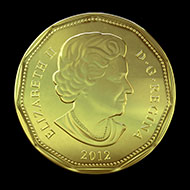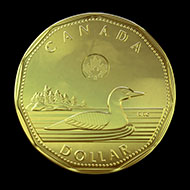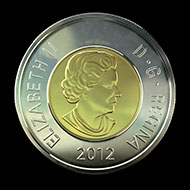May 3, 2012 – The Royal Canadian Mint announces that a new generation of one-dollar and two-dollar circulation coins, which incorporate advanced security features and are manufactured with the Mint’s patented multi-ply plated steel technology has begun circulating on April 10, 2012. More cost-effective than their predecessors and unprecedented in their security, these new coins retain the “Common Loon” and “Polar Bear” designs and physical appearance familiar to millions of Canadian consumers and businesses. Existing one-dollar and two-dollar coins remain legal tender and will continue to circulate alongside this new generation of circulation coins.
The new one-dollar coin with enhanced security features.
“As an industry leader and innovator focused on delivering the best quality and value to its customers, the Mint is pleased to have produced a new generation of one-dollar and two-dollar circulation coins which set new standards in cost-effectiveness, durability and security,” said Ian E. Bennett, President and CEO of the Royal Canadian Mint. “By combining the Mint’s patented multi-ply plated steel technology and sophisticated security features never before seen on Canadian coinage, our new high-denomination circulation coins reinforce the modern and innovative reputation of Canada’s currency system.”
The new two-dollar coin struck with the patented multi-ply plated steel technology.
The new one-dollar and two-dollar coins are manufactured at the Mint’s facility in Winnipeg, Manitoba using the same patented multi-ply plated steel (MPPS) technology from which Canada’s lower denomination circulation coins have been made since 2001. This proven technology, by which a steel core is plated with alternating layers of different metals such as copper, nickel and brass, employs far less metals than alloy coins and produces highly cost-effective circulation coins.
The Mint’s ability to control the plating thickness of each metal layer also provides greater flexibility in controlling electromagnetic signatures. This makes the security of MPPS coins superior to non-plated alloy coins of the same dimensions. Thanks to the superior advantages of its patented technology, the Mint’s Winnipeg facility has been producing MPPS circulation coins for a growing list of international customers looking for the best combination of cost-effectiveness, quality and security.
The next generation of one-dollar and two-dollar circulation coins also incorporates new, visible security features which further enhance the security and integrity of Canada’s coinage system. The reverse (or tails side) of both coins features a laser mark micro-engraving, and the two-dollar coin also contains a virtual image and edge-lettering. With the exception of these additional security features, the new coins will have the same diameter and thickness as the current coins.
These changes to the one-dollar and two-dollar circulation coins, which support the effort to modernize Canada’s currency system, are permanent. The new coins will soon appear in general circulation and will be available through daily business transactions across Canada. All previous versions of the one-dollar and two-dollar circulation coins issued since 1987 and 1996, respectively, remain legal tender and will continue to circulate as usual.
More information on these new coins comprising video clips and images illustrating the enhanced security features, are available on the website of The Royal Canadian Mint.








